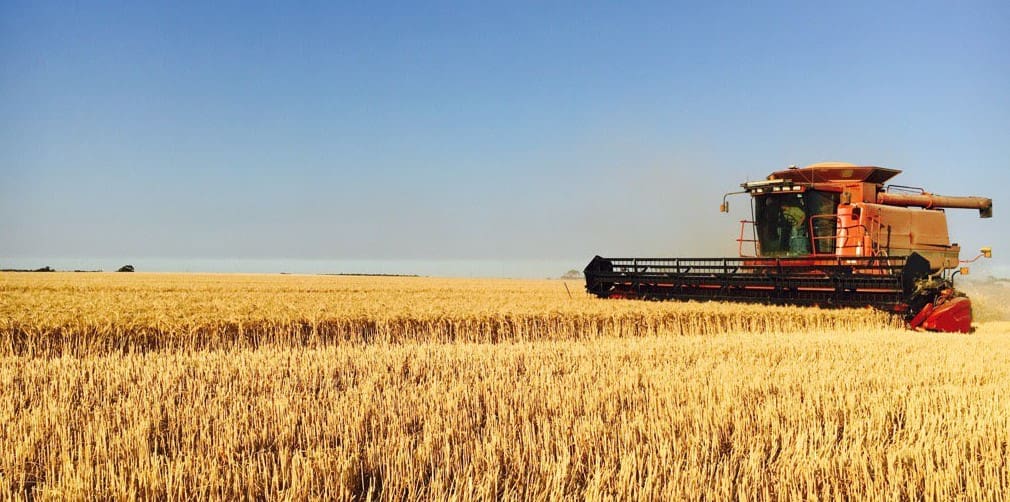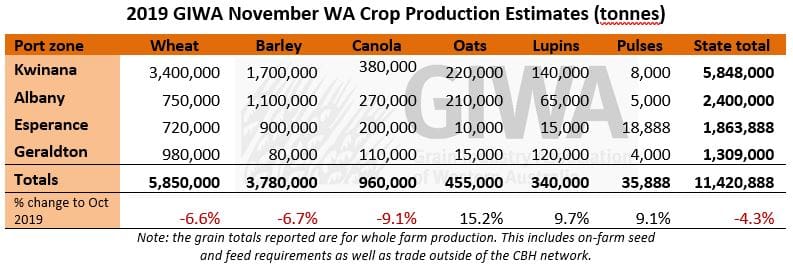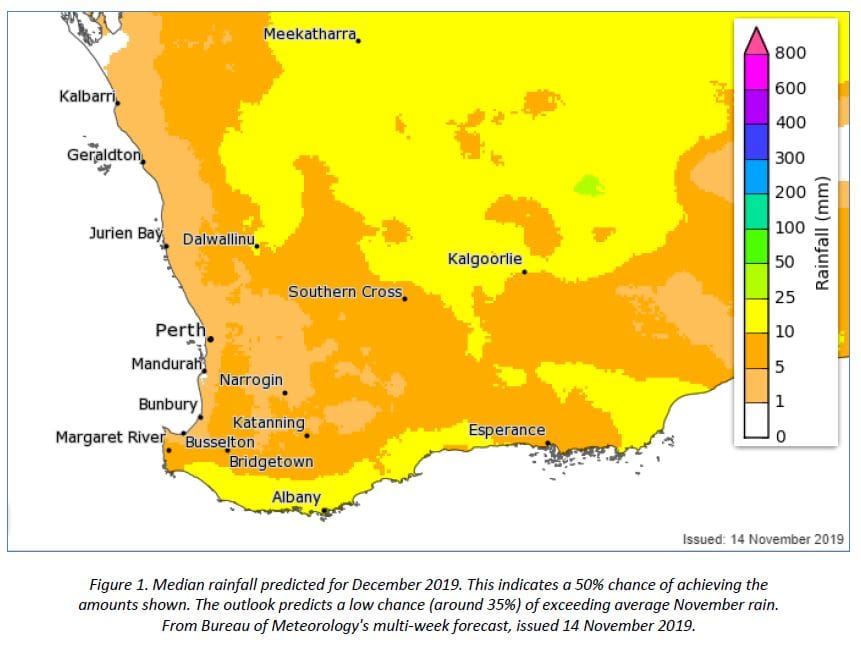WINTER crop harvest tonnages in Western Australia have dropped below earlier forecasts with total production now predicted to be around 11.42 million tonnes (Mt), 4.3 per cent down on last month’s estimates.
In its October report released today, the Grain Industry Association of WA (GIWA) said harvest was now travelling too quickly for most with grain yields in the northern half of the state lower than was estimated a month ago.
Grain yields for all crops in the north of the state where harvesting is 50 to 70pc complete are up to 50pc below recent averages.
In the central eastern regions of the state grain yields are 25 to 30pc below recent averages.
Further south and west where harvesting has only just begun, grain yields are higher, although in most cases still below average.
In the Esperance port zone it is a very mixed bag due to the compounding influence of the frost events in spring.
GIWA Oilseeds Council chair and crop report author, Michael Lamond, said yields in the north were worse than thought, with the Geraldton zone now likely to produce around 1.3 million tonnes (Mt), down from October’s estimate of 1.6Mt.
“As you move south to north of the Great Eastern Highway it improves, but barley screenings are through the roof at 70 per cent with very few loads going malt,” he said.
“Growers in the malt belt who normally get 90pc or more of their crop going malt are getting more like 15pc.
“Malt is a big story. In the south the areas that have traditionally grown feed (barley) like in the Lakes District, growers there are madly grading trying to get into malt because, whilst there isn’t a lot of spread on malt at the moment, there probably will be later.”
Mr Lamond said screenings were high due to the average temperatures being 4.4 degrees warmer in the north, and no rain.
“The barley couldn’t handle it. The wheat has handled it better. Wheat yields are down a bit, but not as bad as we thought. Wheat has a lot lower screenings, but the crops are all over the place. You can have low yield, low protein and low screenings, or the opposite,” he said.
Mr Lamond said on the up side, canola was generally yielding better than expected.
“I had it down for about 960,000t but it could easily go over 1Mt because most of the canola in the south that is just starting to come off is better than it looks,” he said.
“Lupins are down in the north, but look really good all the way down south. So, there could be upside to the lupin tonnage. The short lupin crops have made harvesting difficult although recent higher prices are compensating for the effort.
“Oat grain and hay yields are well down on last harvest, although current high prices have negated some of the downside in tonnage for growers.”
Geraldton Zone
It has been a reality check for the Geraldton zone following on from a very good season last year.
The late start to the season, lack of subsoil moisture, and hot dry finish have combined to potentially return the lowest total tonnage in the zone for over 10 years.
This year the total grain production for the Geraldton port zone is likely to be less than the very dry years in 2017 and 2010 where 1.5 and 1.4Mt respectively were grown. Currently we are on track for 1.3Mt.
Apart from some better crops close to the coast and pockets in the east that received storms, the whole zone is around 50pc below average for grain yields for all crops.
Whole farm averages per hectare of one tonne for wheat, less than 800kg for barley, 600 to 800kg for lupins and 400 to 500kg for canola are commonplace.
Wheat on wheat has been in the 800kg/ha range and wheat on fallow around 1.3 T/ha.
Kwinana Zone
Kwinana North Midlands
Harvesting is well underway in the zone with growers in the eastern areas more than halfway through their programs.
All crops are below average with barley yielding a little less and canola a little more than expected.
Wheat has handled the dry spring better than barley with most loads around 4 to 6pc screenings or less.
Wheat grain protein is up on previous years and interestingly with the lower yields this year, protein is not necessarily as high as one would have thought for the amount of nitrogen applied.
This is a similar story across the state. There are plenty of loads in the 10.5 to 12.5pc protein range although there are also paddocks with low grain yields, low screenings and low protein.
Grain quality rather than grain yield has been influenced more this year by soil type, rotation, timing and amount of fertiliser, and whether or not the country had been recently ameliorated.
This region and further north experienced spring temperatures of more than four degrees higher than average.
Combined with little rainfall, this has caused wheat floral abortion and the lack of sites to fill, and probably explains some of the very erratic grain quality results.
The eastern areas of the zone are well down on tonnage for all crops. The western areas have fared better although most growers will be below average across their programs.
Barley screenings are very high and the traditional malt belt in the zone will produce very little malt quality barley.
Dedicated malt growers who would normally deliver 90pc of their barley as malt have struggled to get 15pc into malt stacks.
Canola grain yields are low although most paddocks have been yielding more than was expected in September. Lupins are well down on recent years.
Kwinana South
Growers are still on barley and canola in the region with only small quantities of wheat delivered to date.
Barley grain yields are lower than was thought before harvesting started and canola is yielding a little more than first thought.
Paddocks are down on average grain yield across the board.
Crops generally pick up south of the Great Eastern Highway and whilst most are below average, many are only slightly rather than well below average, as is the case further north.
The trend across the state with high screenings in barley is a similar story in the region and whilst wheat north of the zone generally has been okay for screenings, there are more loads with screenings up around 10pc.
The stubbles are heavier moving south and west in the state and the lack of spring rain has caused crops to transpire to death due to more leaf area from the dry and hot conditions in the spring resulting in higher screenings.
The western areas of the zone are going to be down on recent averages although not well below average.
Kwinana North East
The Kwinana North East zone is well into harvest and most growers are getting through their programs quicker than they would like.
The wheat held up for a long time in September waiting for rain that did not arrive.
The result is going to be below average for most growers with only fallow and the better soils getting close to average grain yields.
The brutal finish was just too much for crops.
The good red country has been going better than the traditionally safe Mallee soils as the moisture release out of the profile was slower, resulting in less biomass produced by crops.
For most, wheat will end up closer to 0.8-1.0t/ha than 1.2-1.3t/ha as was thought prior to harvest.
The region is awash with high protein and the high screenings mean growers have little opportunity to gain significant dollar benefit from the higher grain proteins.
There are some pockets which received storms that will push averages up and go better than others although these are the exception.
Even though the region will be down on average grain yield for most, there will still be a reasonable tonnage coming out of the zone as there are no really poor patches that will not be harvested and the crops south of the Merredin line improve significantly as they often do.
Albany Zone
Albany West
Early indications for the Albany West zone are very promising, with barley and canola yielding as expected.
Barley screenings are high although closer to 25 to 30pc rather than greater than 60pc for much of the state.
There is still a long way to go with harvest in the region and the wash out of the frosts on barley will not be known for several weeks.
Canola seems to have escaped most of the frost and grain yields are at least average for those harvested to date.
There has been little wheat taken off so far, and what has been delivered has yielded well with low screenings and good protein.
Most growers are expecting a good year in the region and a lot of the grain production for the state will come from here along with the western regions to the north.
Albany South
Growers have only recently started on barley and canola. Grain yields vary a lot depending on soil type and topography.
Canola grain yields are ranging from a few hundred kilograms per hectare to over 1.5t/ha with oils generally in the low 40s.
Barley grain yields are 20 to 30pc lower than expected as the frosts have had more affect than first thought.
The frosts hit barley at early milk stage and this has really taken the top off yields right through the region.
Barley is already well gone for colour and there will little or no malt in the region.
The far eastern areas on the Esperance port zone boarder have been returning some incredible water use efficiencies, with barley going between 1.5 and 2t/ha on just over 100mm of growing season rain in some cases.
Albany East (Lakes Region)
The Lakes District is well into harvest with most crop yielding as expected.
Even though it was a low rainfall year most crops escaped the frost and the region did not receive the heat in the spring as further north.
The season has resulted in below average grain yields for most although not the very erratic results from paddock to paddock as in other areas of the state.
The region recently has been producing barley for maximum tonnage and not for quality, although this year with barley screenings relatively low and protein not over the top, many growers are either hitting malt grades or grading to get into malt grades.
Wheat yields have been just below average for most so far and grain quality good. The gradient in yields goes up quickly as you move west in the zone and these growers will end up having a good year.
The lack of frost has been a relief for most in the zone for a change and less area will be lost to frost than is normally the case for the region.
Lupins have podded well and whilst short will return a profit for most growers in the region.
Esperance Zone
The Esperance port zone has some very good areas along the coast and some very poor areas in the north and north west.
The coastal areas have had a dream run with an earlier start than most, little waterlogging and no frost. Grain yields for all crops will be above average and grain quality is expected to be good.
Moving away from the coast, the results so far are very erratic due to the dry spring and the influence of frost.
The frost has taken the top off many barley and canola crops and grain yields swing wildly through paddocks.
Most barley in the zone is grown for feed and the high screenings for many loads have been less of a problem than contamination from wheat volunteers.
Canola grain yields in the better areas have been better than expected although in the north and eastern areas, the dry, frost and rain prior to harvest has resulted in some very poor yields and some undeliverable loads due to sprouting.
There is little wheat harvested to date and the estimated wheat tonnage is a bit of an unknown.
Wheat was at a more vulnerable growth stage when the frosts hit and many were cut for hay.
Some early vindications are that the frosts have had more of an effect on wheat than expected and tonnage is likely to be lower than current estimates.
Season outlook
WA Department of Primary Industries and Regional Development’s (DPIRD) Ian Foster said after some rain in early November, little to no rain was expected over southern WA for the rest of the month.
The Bureau of Meteorology’s medium range rainfall outlook indicates December rain is likely to be below normal for the south west and southern agricultural areas, with a neutral outlook elsewhere.
Figure 1 shows the median rainfall forecast for December.
Seasonal rainfall outlooks from Australian and international models indicate an easing of the negative rainfall outlook over December to February.
Rainfall probabilities are close to neutral for most of the state, coming from the likely decay of the strong positive Indian Ocean Dipole event.
Sea surface temperatures are expected to warm to the north of WA and this may improve summer rainfall chances for the north of the state.
Bureau of Meteorology seasonal outlook summary, issued 14 November 2019:
- Drier than average for the second half of November and December for most of the country; summer rainfall likely to be below average in parts of the east but above average in parts of north west Australia.
- Above average daytime temperatures very likely across Australia for summer.
- Minimum temperatures—mixed outlook for the remainder of November. December to February nights generally warmer than average.
- Climate influences – a strong positive Indian Ocean Dipole (IOD) likely to persist until mid-summer, and a negative Southern Annular Mode (SAM) is likely for the last two weeks of November until at least early December.
Source: GIWA, DPIRD







HAVE YOUR SAY